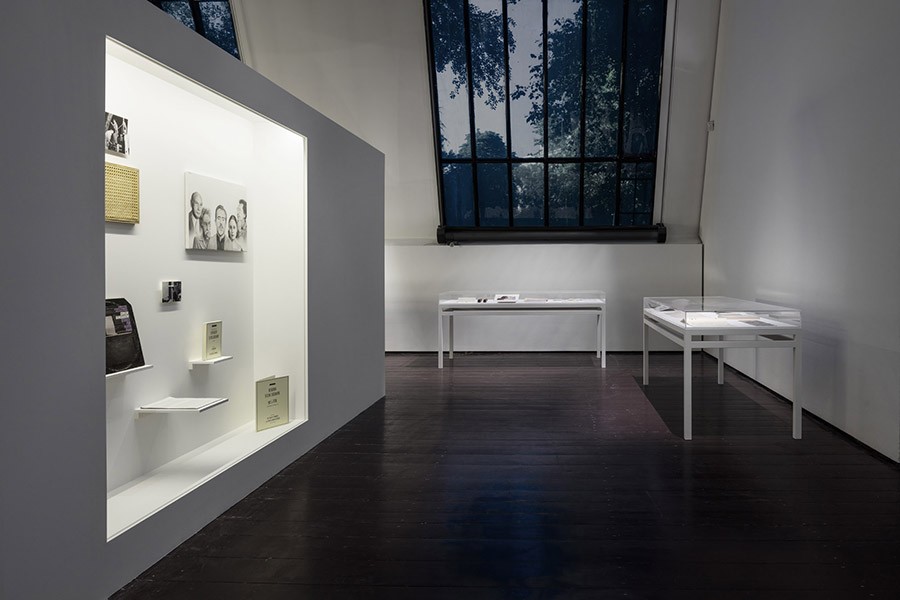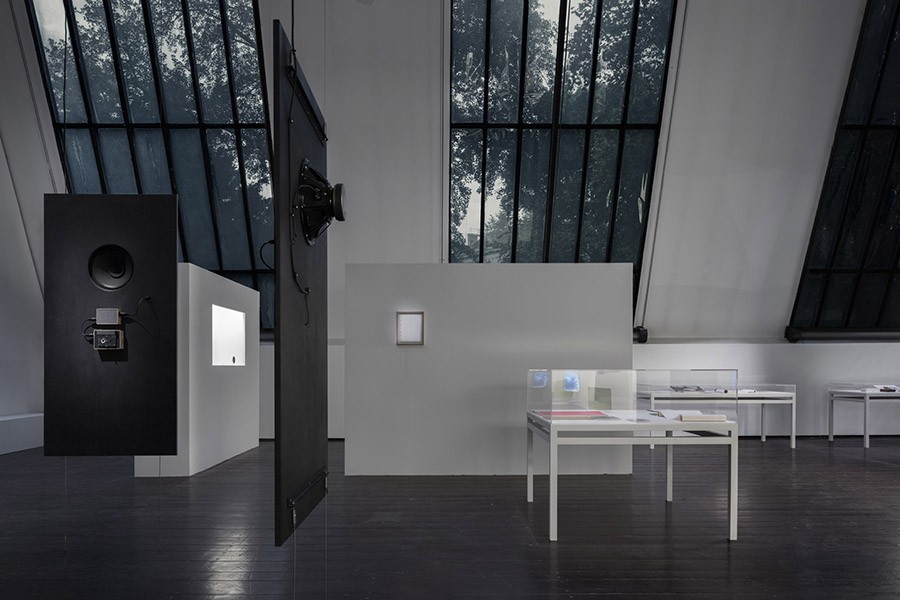Mario García Torres
An Arrival Tale
17 Jun - 20 Nov 2016

Mario García Torres: Sounds Like Isolation to Me, n.d. Installation view "An Arrival Tale", TBA21, Vienna 2016. Photo: Anders Sune Berg

Mario García Torres: Sounds Like Isolation to Me, n.d. Installation view "An Arrival Tale", TBA21, Vienna 2016. Photo: Anders Sune Berg

Mario García Torres: The Way They Looked at Each Other, n.d. Installation view "An Arrival Tale", TBA21, Vienna 2016. Photo: Anders Sune Berg
MARIO GARCÍA TORRES
An Arrival Tale
17 June – 20 November 2016
Appropriation, storytelling, reenactment, repetition, and reportage are some of the strategies that the Mexican artist Mario García Torres (born 1975 in Monclova, Mexico) deploys to uncover (hidden) histories, narratives, and strategies embedded in sites and places and thereby to highlight the limitations of factual evidence and the subjectivity of historical records and objects. An Arrival Tale, an exhibition at Thyssen-Bornemisza Art Contemporary (TBA21) Augarten, uses a conceptual gesture that detaches the works by the artist in the TBA21 collection from their original contexts and descriptions and offers them as a collection of narratives and artistic experiments open for reinscription. García Torres states, “An Arrival Tale is an exhibition that pretends to use a number of my works from the TBA21 collection to argue that the space of arrival, the space where one can reinvent oneself, could be an interesting one, and one that has historically been a space to thrive.”
An Arrival Tale was conceived in light of TBA21’s engagements with the contemporary refugee crisis and, more generally, within the condition of continuous global migration and displacement. The exhibition seeks to collect, describe, and complicate narratives of transplantation, pointing to migrations, displacements, relocations, and resettlements, which span both time and disparate geographies. It also proposes to read the story of exile in the framework of Paolo Virno’s notion of an “engaged withdrawal,” a strategy of slipping away from oppressive power with the intention of creating new communities. The conceptual gesture of reimagining stories is not an attempt to diminish the scope of trauma inherent in the process of migration but rather is an investigative proposition to think specifically about the nexus of departure, arriving, and returning, tropes deeply invested within the notion of exile. Making space to ask questions, also through dialogues with actual migrants and asylum seekers in Austria, allows for an exploration of the reality, fantasy, and overall complexity of the trajectories of displacement and movement.
The gesture of reimagining the frame of the exhibition itself is intended to open up new possible readings, thus allowing for speculation on the possibilities of reinvention and transcendence. The concept is signposted loosely by two narrative moments—the arrival and the return—manifested through two specific artworks: the former through Tea and the latter through a new commission titled “The Way They Looked at Each Other,” exploring an existing body of research originally investigated for an essay by García Torres published in Frieze in 2012. Like much of García Torres’s work, the exhibition itself questions narratives, both by looking back and complicating historical descriptions and by looking forward and projecting new possibilities.
What are the actual conditions and what are the dreams, what are the politics housed in the bodies of the people moving, what is left behind, and what is met anew? Is arrival a fresh start, or is it implicitly haunted by challenges of absence and disembodiment? In the exhibition the act of dislodging the meaning of the existing body of work and its epistemology is a sort of twisted archaeology of García Torres’s own practice, thus allowing his works made at different times to be read within the context of the political sphere and human experience.
An Arrival Tale
17 June – 20 November 2016
Appropriation, storytelling, reenactment, repetition, and reportage are some of the strategies that the Mexican artist Mario García Torres (born 1975 in Monclova, Mexico) deploys to uncover (hidden) histories, narratives, and strategies embedded in sites and places and thereby to highlight the limitations of factual evidence and the subjectivity of historical records and objects. An Arrival Tale, an exhibition at Thyssen-Bornemisza Art Contemporary (TBA21) Augarten, uses a conceptual gesture that detaches the works by the artist in the TBA21 collection from their original contexts and descriptions and offers them as a collection of narratives and artistic experiments open for reinscription. García Torres states, “An Arrival Tale is an exhibition that pretends to use a number of my works from the TBA21 collection to argue that the space of arrival, the space where one can reinvent oneself, could be an interesting one, and one that has historically been a space to thrive.”
An Arrival Tale was conceived in light of TBA21’s engagements with the contemporary refugee crisis and, more generally, within the condition of continuous global migration and displacement. The exhibition seeks to collect, describe, and complicate narratives of transplantation, pointing to migrations, displacements, relocations, and resettlements, which span both time and disparate geographies. It also proposes to read the story of exile in the framework of Paolo Virno’s notion of an “engaged withdrawal,” a strategy of slipping away from oppressive power with the intention of creating new communities. The conceptual gesture of reimagining stories is not an attempt to diminish the scope of trauma inherent in the process of migration but rather is an investigative proposition to think specifically about the nexus of departure, arriving, and returning, tropes deeply invested within the notion of exile. Making space to ask questions, also through dialogues with actual migrants and asylum seekers in Austria, allows for an exploration of the reality, fantasy, and overall complexity of the trajectories of displacement and movement.
The gesture of reimagining the frame of the exhibition itself is intended to open up new possible readings, thus allowing for speculation on the possibilities of reinvention and transcendence. The concept is signposted loosely by two narrative moments—the arrival and the return—manifested through two specific artworks: the former through Tea and the latter through a new commission titled “The Way They Looked at Each Other,” exploring an existing body of research originally investigated for an essay by García Torres published in Frieze in 2012. Like much of García Torres’s work, the exhibition itself questions narratives, both by looking back and complicating historical descriptions and by looking forward and projecting new possibilities.
What are the actual conditions and what are the dreams, what are the politics housed in the bodies of the people moving, what is left behind, and what is met anew? Is arrival a fresh start, or is it implicitly haunted by challenges of absence and disembodiment? In the exhibition the act of dislodging the meaning of the existing body of work and its epistemology is a sort of twisted archaeology of García Torres’s own practice, thus allowing his works made at different times to be read within the context of the political sphere and human experience.
